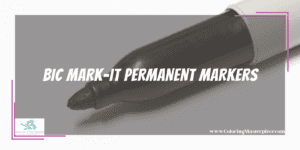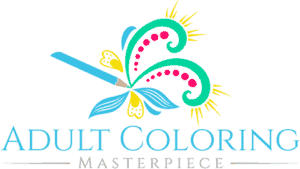Sharpies are no longer reserved for labeling. There are countless marker styles and even more color options, which make them a very attractive tool to use in coloring books. But does this mean that you actually can use Sharpies in coloring books?
You can use Sharpies for coloring books, but they will always be prone to bleeding through. This means that Sharpies will not be a good choice for coloring books with designs on both sides of the page. Use finer-tipped Sharpies in coloring books with a barrier underneath to inhibit bleed-through.
Luckily, plenty of people have gone through the trial and error process involving Sharpies. Read on to learn why you should be wary when using them, how to get the best results, and a few similar alternatives.
Why Do Sharpies Bleed Through Paper?

Markers, in general, are made using a liquid medium (usually water or something like alcohol) to spread the ink around. When you use the marker on paper, the liquid soaks into the cellulose fibers. After a period, the liquid evaporates and leaves the pigment behind.
Sharpies use an aggressive blend of solvents to carry the ink, including alcohols and ethylene glycol monobutyl ether. These cut through the paper fibers more effectively than water might, increasing the chance of bleed-through.
These solvents do a great job of increasing the permanence of the ink, but they also limit their use in coloring applications.
Tips for Using Sharpies in Coloring Books
Do not let this ward you off from using Sharpies. There are plenty of ways that you can still use them for coloring books, but your bets will be to:
- Pick types that are less prone to bleeding through
- Protecting the other pages in your coloring book
- Using lighter colors that are easier to cover up
These are some simple things you can start with to give yourself the best experience using Sharpies in coloring books.
Pick Sharpies that are Less Likely to Bleed Through
There are plenty of different types of Sharpies, and they all have some pretty unique features. However, when you are picking Sharpies to use in coloring books, you want to focus on the types that are less prone to bleeding through.
For the most part, this will encompass your Ultra Fine Point and Fine Point varieties. (You can even find them in combination packs, giving you more variety when coloring.) While these still bleed through, the issue is less severe than it would be with larger tips. These also have the most variety of colors for any Sharpie type, and the narrow tips are great for details.
Chisel tip Sharpies can also be useful, but they do bleed through more than finer points. Their unique tip shape will let you make broad, medium, and fine strokes. Unfortunately, these do not offer the same variety of colors as finer points.
Protect Your Coloring Book
As long as your coloring book has designs on one side of the page, you have a few options for protecting your coloring book and limiting the effects of bleed-through. The best thing you can do is remove the page you are coloring on from the book. This is easier when your coloring book has perforated pages, or the pages are printed on single sheets.
You can set the single page on another thicker sheet of paper to soak up the bleed-through, but consider using a placemat as a reusable barrier. This is not an issue if you are coloring on a table or surface that you do not mind marking up.
If you are not confident in your ability to remove the page without damaging the book, you can use a barrier to prevent the bleed-through from soaking onto the next page. You can use heavier cardstock or cardboard, but the cardstock may be too thin, and the cardboard mat is too thick. If you can find a thin layer of plastic, that will be your best option. The plastic will be impermeable enough to block bleed-through, and it should also be thin enough to slip into your coloring book.
Use Lighter Colors
You can use lighter-colored Sharpies in combination with other art tools to create a multidimensional look. The lighter colors will still bleed through, but when they do, they will be less noticeable.
Using lighter colors also makes it easier for you to cover up any errant marks. If a darker color bleeds through, you will have little chance of covering it up. At that point, you will need to take creative liberties with the design, affecting the original integrity of the coloring page.
The Best Ways to Utilize Sharpies for Coloring Books

Instead of using Sharpies in your coloring books to fill, consider using them to outline forms or add texture. The bold color is great for both of these things and using the Sharpies on top of a layer of another medium will limit the bleed-through. This can be a bit nerve-wracking because the Sharpie could easily mar the work you have done, so be very careful when using it on top of your coloring page.
Outlining
Adding definite outlines to your work can make the coloring seem more finished. This can be as simple as going over the original lines of the piece or adding your own to make it more lifelike, but Sharpies are the best tool for the job. They will not waver when used over any buildup of oil or wax from crayons or colored pencils, and they are bold enough to sit on top of other markers.
Defining with Texture
Ultrafine point Sharpies are great to use on top of coloring to add extra texture using methods like:
- Dotting
- Dashing
- Hatching
- Scribbling
The tip will be fine enough to not overpower the piece underneath, and the fine tip Sharpies are still strong enough to sit on top without smearing or wiping off.
Learn more about coloring with markers HERE.
Adding Metallic Contrast
Sharpies have some unique metallic-colored markers that can provide an interesting contrast to your piece. You can use them to outline or texture; either way, the shine is sure to brighten up the page. These do apply a bit more wet than traditional markers, but it seems like more of the solvent bleeds through than the metallic pigment.
Markers Similar to Sharpies You Can Use in Your Coloring Book
Sharpies have a reputation for a reason, so it can be hard to find other options that come close. If you are not looking for the same level of permanence, however, some great markers boast bold color and minimum bleed-through, such as:
- Crayola Take Permanent Note Markers
- Bix Mark-It Permanent Markers
- Prismacolor Premier Double-Ended Markers
These are not exact Sharpie dupes, but they have some features that make them useful in place of Sharpies.
Crayola Take Permanent Note Markers
The Crayola Take Permanent Note Markers work well on a variety of surfaces, but when it comes to paper, they seem to bleed through about as much as Sharpies do. The plus side? Take Notes to have a weaker smell, so they might be a better option for someone who is easily agitated by that strong Sharpie scent.
The Take Permanent Note Markers also seem to have more vibrant colors. At this time, they do not have as much of a variety as Sharpie markers do, but the colors you have access to are either very close to Sharpies or even brighter.
BIC Mark-It Permanent Markers

As with the Take Note permanent markers, Bic Mark-Its have a lower level of odor. They also seem to bleed through less frequently and with less aggression, which is a major plus.
They can be more difficult to find, and a search might direct you to Bic Intensity permanent markers. While these are still great markers, they seem to bleed through more than Mark-Its, so make sure you are getting the exact type you are after.
Prismacolor Premier Double-Ended Markers
While these are not permanent marker options, the Prismacolor Premier double-ended markers are one of the best sets out there for coloring. They have double-ended tips that will either help you fill the page or fit into tiny nooks and crannies. You will notice the colors are pretty vibrant, and you will have more color variety with the Prismacolors. They are also a bit easier to blend, so that should be a major bonus. Do not worry too much about their permanence. Because these markers are made specifically for art, they intend to hold vibrancy for a long time on the page.
Frequently Asked Questions
What paper weight is best for Sharpies?
You should use paper that is at least as thick as cardstock, or about 250 g/m. You need to test out what works best for you. Each artist uses markers differently, so while some may get away with cardstock, others with a heavier hand might need something thicker or less porous.
Can you blend Sharpies?
You can blend Sharpies. This process usually involves using multiple colors in a gradient or using some other solvent to facilitate the blending process.
Maximize the benefits of coloring with my free adult coloring eBook and by signing up for my email newsletter HERE!
Disclaimer: The information provided by ColoringMasterpiece.com (“The Site”) is for general informational purposes only. All information on the Site is provided in good faith, however, we make no representation or warranty of any kind, express or implied, regarding the accuracy, adequacy, validity, reliability, availability, or completeness of any information on the Site. Under no circumstance shall we have any liability to you for any loss or damage of any kind incurred as a result of the use of the Site or Reliance on any information provided on the Site. Your use of the Site and your reliance on any information on the Site is solely at your own risk. This blog post is for educational purposes only and does not constitute legal advice. Please consult a legal expert to address your specific needs.
Terms and Conditions: https://coloringmasterpiece.com/terms-and-conditions/
